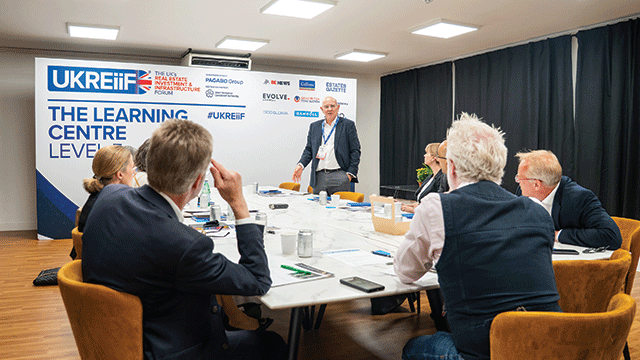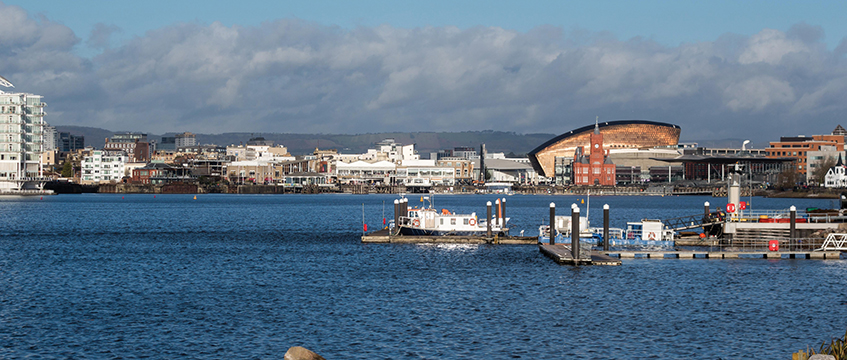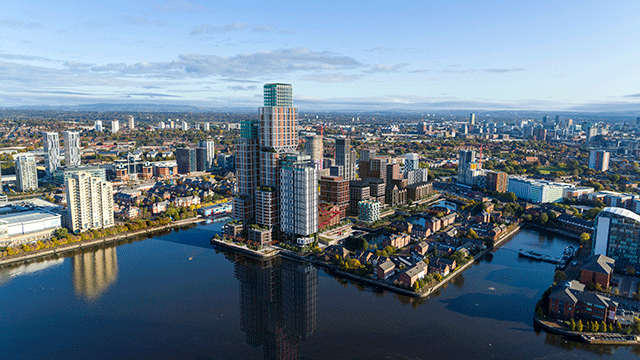Cardiff is racing to hit the government’s net-zero targets, but to make this a reality, it will require buy-in and major investment from both UK and international backers, according to real estate experts in the Welsh market.
Public and private sector professionals from across Cardiff’s built environment gathered for EG’s latest Cities session, held at restaurant Pasture, to discuss the opportunities and challenges the city faces in reaching its objectives.
The Welsh government is not only targeting net zero by 2050, but also interim targets for 2030 and 2040, while Cardiff council’s One Planet Cardiff strategy has set a goal for the city to become carbon neutral by 2030.
Councillor Huw Thomas, leader of Cardiff Council, said One Planet Cardiff sets out a “very firm understanding” of what the main sources of emissions are in the city.
“Some of them are within the council’s control, [but the] majority is not,” he said.
One of the key challenges in addressing that hurdle, according to Thomas, is getting all public sector levels on the same page. Thomas also emphasised the importance of working with the private sector on what can be packaged up as an offer to both Welsh and central governments.
“When it comes to housing, we are talking about a monumental shift at all government levels, in terms of capital input, to shift away from gas boilers in particular and insulation,” said Thomas. “We can beat the drum, we can set some directions of travel, but we also need two other tiers of government above us to come with us.”
Jonathan Latham, director in the property management team at Savills, said the targets present an opportunity for real estate owners to manage increasing costs and, eventually, enjoy returns on their investment.
“Spiralling inflation and build costs are putting real pressure on landlords to modify and invest in their buildings, but also it’s the utility crisis that is hitting, so the buildings that are not futureproofed have seen [utility] costs spiral,” he said.
“[If] you look at a forecast and payback period on an investment, you can see that you can get your properties into a much better place in three or five years’ time. So there is definitely motivation for landlords to spend that money.”
Latham added that it is about “explaining that to occupiers” and “taking people on that journey” to understand that, while each stakeholder has their own commitments, properties can be taken “to a much better place”.
Attracting inbound investment
The Welsh market is keen to boost its attractiveness to investors, but the ongoing financial squeeze remains a major obstacle.
The main issue for Richard Shaddick, senior business development manager for trade and inward investment for the Welsh government, is how to drive innovation in the housing sector and promote Welsh projects to overseas investors.
He highlighted commitments from the likes of Qatar and the UAE to spend £10bn in the UK, much of which are focused on London and in the Northern Powerhouse.
One of the main challenges is attracting some of that money to Welsh projects.
“One of the biggest challenges, for all of us, is funding,” said Shaddick. “We are not immune to that – our budget has been cut as well. It’s having projects of scale that investors want, and unfortunately we have not got those at the moment.
“We have got some great projects in Cardiff and Swansea. It’s a case of how we generate income to the projects and how we bring forward housing projects at scale, while factoring in aspects such as the carbon agenda.”
For Caroline Jones, associate director in the development team at Savills, Wales’ pipeline offers much potential for new investment. “Opportunities at present include a ten-year pipeline of work for two adjoining local authorities to deliver much needed affordable housing, of which will be built a highly energy-efficient standard,” she said.
Ioan Prydderch, partner at Hugh James, said his team saw “lots of ambition” in the Cardiff market, but “a lot of challenges”, a major one being cost of debt.
“Money is very tight,” he said. “We see it across the public, social housing and private sectors – all three are struggling in a particular way.”
Housing sector challenges
Wayne Harris, director of asset management at social housing provider Pobl, is keen to correct a misconception that housing associations are flush with money. “We’re running on the ragged edge in the social housing sector,” he said.
In the rental sector, Harris said the core challenge is demonstrating expenditure versus investment. He uses the example of justifying a £10m loan to build a number of new homes, rather than using the same amount to renew the windows and roofs of existing owned properties.
For Harris, legislative incentives could help overcome that hurdle. He points to difficulty “without some form of legislative change” to enable the housing association to capture a portion of the amount that residents would save from their energy bills as a result of that investment.
“If we could have some portion of that back, we stand a chance of at least partially funding that investment, but it would be a very long period of return,” he said.
Harris said using PV panels for renewable energy is vital in ensuring homes can be delivered in a way that makes the planet a better place – Pobl’s circa 650-home energy retrofit project in Swansea relies heavily on PV – but the housing association has no choice but to scale its usage back, given the Welsh Housing Quality Standard’s proposals for a “fabric-first” approach.
Meeting the required SAP 75 rating would exclude use of renewable technologies such as PV. As such, Pobl is having to redirect its investment into wall insulation, ultimately slowing down the pace of progress.
“I’m not criticising that policy. I get why that’s being done,” he added. “Welsh government wants to push the sector to a place where they can then say there’s no excuse for not moving to renewable heating, so air source heat pumps will operate more effectively when you have a good level of insulation within the property.”
Net-zero game changers
There are several development sites with immense potential to underpin further transformation in Wales. Cardiff Capital Region’s Aberthaw project is one of them. CCR is aiming to demolish and repurpose the former power station into a next-generation energy park, including hydrogen production.
Gavin Powell, head of innovation, clusters and skills at CCR, outlined his hope that Aberthaw could be used as a lighthouse project, particularly for South Wales, in terms of a testing ground for research and innovation, and applying learnings to regions such as Cardiff, especially around hydrogen.
On Cardiff’s high street, Thackeray Estates’ £100m redevelopment of the historic Howells Building promises to be another game-changer. The site, once home to a House of Fraser department store, is becoming a mixed-use scheme.
Giles Hoare, investment director at Thackeray Estates, said his team is talking to occupiers who have never looked beyond London that now want to come to the city.
“Cardiff is performing like Manchester or Newcastle or Bicester. It’s on that level now,” said Hoare, adding that the city is proving it can hit similar turnover figures.
Thackeray has just submitted plans for the second and third phases of the project. It is also eyeing opportunities for other sites it could acquire and turn into “the next great site in Cardiff”.
Balancing investment with returns
The family office is keen to do its part for the planet, but like the experiences of many at the table, cost remains a major problem.
“It’s hard for us to value return on investment from a social perspective, being a privately owned property fund,” said Hoare.
The team considered ground source heat pumps for its project, but found it was “quadruple” the cost of using the standard existing electrical system.
“I know there are graphs [suggesting] that by 2040 you’ll have a return on that, but it’s hard to take that view if you’re a pension fund or similar,” he said.
“We struggle with that. We want to do our bit for the built environment. We want to do what we can, but ultimately it has to make financial sense.”
James Pentlow, asset manager at Schroders, which recently won a £500m mandate from Wales Pension Partnership, is also contending with balancing out the level of return on investment. He noted St William House, the Lloyds building Schroders bought in 2010, “would be much easier to knock down” than retrofit.
“It’s a sad state of affairs, the way things were built, the lifespan of existing structures,” he said. “For Schroders and the pension funds that invest with us, ESG is critical so we wouldn’t want to do that, but it is more expensive and time-consuming. You are working with a structure that is not necessarily fit for purpose”.
Pentlow is encouraged, however, that investors are increasingly on the same page about the value ESG can add to a property, highlighting that social value is especially “huge”.
“Investors are seeing that as a return,” he said. “Five years ago, green credentials were less important, especially on the debt side. Now, all the lenders care about now is that you have a futureproofed building.”
Retail and leisure has a major part to play in bringing communities together, with Pentlow highlighting Schroders’ leisure district Mermaid Quay as an example.
“While it’s not always possible from a viability, financial perspective, to meet all net-zero targets, retail and leisure is very aligned with social value,” he said.
The magic of modern technology
One famous leisure destination could also provide the Cardiff market with some inspiration for reducing the city’s environmental impact.
Peter Hurn, partner at Hugh James, pointed to Disneyland Paris as an exemplar, where there are solar panels “above every single space” of its extensive car parking lots.
“If you take all of the supermarkets we have dotted around the city, if they could be encouraged in some way to [do similar], think how much they can generate and put back in the grid [through] their car parks,” he said.
Savills’ Latham agreed that the city requires a much-needed shift to modern technology to futureproof its real estate, adding that a broader shift in the public mindset is still needed to enable this.
“There has to be transparency about the reason the world is moving in this direction and trying to become more sustainable, because you will see the savings if you follow well-planned strategies,” he said.
For Shaddick, modular housing could be a key component in the Welsh government’s target to build 20,000 low-carbon affordable homes for rent by 2026. He posits that a contractor could deliver part of the solution. “We want to bring this technology into Wales, create these local jobs and spread prosperity around Wales,” he said.
Gareth Davies, operations manager for major projects at Cardiff Council, identified resource and innovation as the main challenges in the market.
“We need more people in the marketplace,” he said “We need more business. Wales has suffered in the past couple of years with builders going under, and the effects of that have been critical.”
Lewis Dean, head of Wales Innovation Network, pointed to a “chance for Welsh universities to refocus and think about how we attract more UK-level grant funding”.
“[There is] a real opportunity for us to think about how we [convey] Wales’ strengths in R&I,” he said.
Powell is keen to see Wales become bolder and lead the way on oft-debated initiatives such as carbon credits.
“If you can get a scheme together which is trusted, [and] supported by the Welsh government or similar, that could be the leading selling point for Wales,” he said.
“That’s what I’d love to see, particularly in Cardiff – that’s the opportunity for us to lead and be known for doing something different. If we fail, that’s fine – we just learn.”
To send feedback, e-mail pui-guan.man@eg.co.uk or tweet @PuiGuanM or @EGPropertyNews
In partnership with
Discover which agents have been most active in Cardiff so far this year>>
Photo © Phil Bird/imageBROKER/Shutterstock













